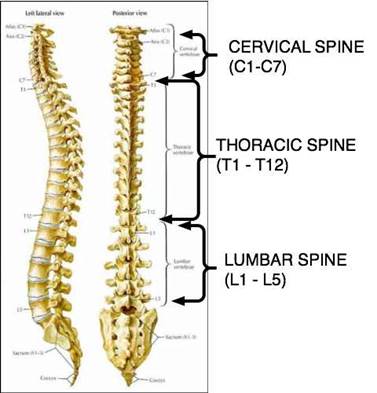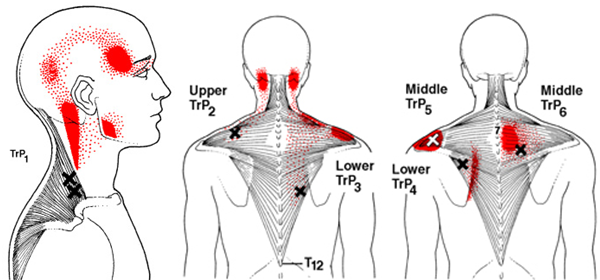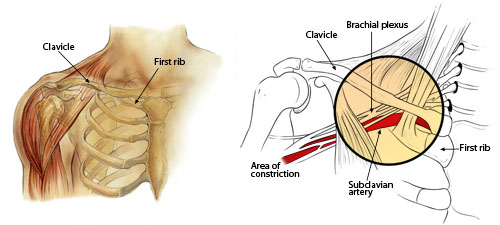There are many sources of dysfunction in the upper back, especially when we consider the numerous joints and the interlacing of muscles that comprise the thoracic spine and rib cage. If one muscle or joint is injured or inflamed, it can create a cascade of pain and dysfunction that can be difficult to treat.
CHIROPRACTIC TREATMENT AND UPPER BACK PAIN
 The mid and upper back is known as the thoracic spin e. It is the largest portion of the spine, consisting of 12 of the 24 spinal bones (vertebrae). In comparison, the neck (cervical spine) has 7 vertebrae while the lower back (lumbar spine) has 5 vertebrae. All of the thoracic vertebrae articulate with ribs and together protect the thorax, hence the name, thoracic spine. Upper-back pain is a phenomenon that affects all age groups. Upper back pain, while common, receives much less attention than neck and lower back pain. As a side note, some chiropractors prefer to call their manual joint treatments adjustments rather than manipulations. The term adjustment implies appropriateness and specificity, while some may associate manipulation with imprecision or even the devious manipulation of another’s feelings and behavior.
The mid and upper back is known as the thoracic spin e. It is the largest portion of the spine, consisting of 12 of the 24 spinal bones (vertebrae). In comparison, the neck (cervical spine) has 7 vertebrae while the lower back (lumbar spine) has 5 vertebrae. All of the thoracic vertebrae articulate with ribs and together protect the thorax, hence the name, thoracic spine. Upper-back pain is a phenomenon that affects all age groups. Upper back pain, while common, receives much less attention than neck and lower back pain. As a side note, some chiropractors prefer to call their manual joint treatments adjustments rather than manipulations. The term adjustment implies appropriateness and specificity, while some may associate manipulation with imprecision or even the devious manipulation of another’s feelings and behavior.
THORACIC DISC HERNIATION
Due to the limited motion in the thoracic spine caused by the bony barrier of the ribs, thoracic disc herniations are relatively rare. But when they do occur, they can create much pain and dysfunction. Whenever practical and safe, conservative (nonsurgical) care, such as chiropractic, is advisable prior to the use of more invasive procedures, such as spinal injections or surgery.
The goal of the chiropractic treatment of thoracic disc herniation is to reduce pain and dysfunction while the body heals itself. Since most disc extrusions naturally regress in a few months, chiropractors will attempt to reduce the pain and pressure caused by the disc herniation.
Some chiropractors will recommend nutritional support, such as proteolytic enzymes, to reduce the pain and swelling associated with a disc herniation.
MYOFASCIAL PAIN SYNDROME
Fascia is a layer of connective tissue that contributes to the supportive structure of the spine and musculoskeletal system. The fascia invests, or surrounds, the muscles and allows for the smooth gliding of one muscle upon another. Investing fascia helps to prevent muscles from adhering to each other. With injury, chronic postural stress, or overuse, myofascial trigger points or myofascial adhesions may develop – all commonly referred to as myofascial pain syndrome.
Chiropractors treat myofascial pain syndromes such as myofascial trigger points or adhesions with manual myofascial therapy. This therapy normally includes the use of direct pressure upon the trigger point, or the use of active anchor-and-stretch myofascial release techniques.

JOINT DYSFUNCTION
The thoracic spine is a marvel of joint interaction and complex motion patterns. Composed of a total of 220 separate joints, it makes up the lion’s share of the 313 total joints in the entire spine. With this many interactive articulations it is easy to see that maintaining normal joint function, motion, and position is important. Chiropractors treat thoracic joint dysfunction with chiropractic adjustments. There are a variety of chiropractic adjustment techniques that can be used to adjust a dysfunctional joint:
- Most chiropractors employ manual adjusting techniques that utilize precise thrusting adjustments to help normalize joint function.
- Chiropractors can also use softer directional adjusting techniques or adjusting instruments to accommodate the needs of the patient.
THORACIC OUTLET SYNDROME
Thoracic outlet syndrome (TOS) is a disorder in which the nerves of the brachial plexus and blood vessels are compressed. This compression can cause great pain and altered sensations such as a “pins and needles” sensation in the hands. Treatment of thoracic outlet syndrome can include stretching, manual trigger-point therapy, and myofascial anchor-and-stretch release techniques to the affected muscles. Chiropractors may also include adjustments and postural instruction.
THORACIC/SHOULDER DYSFUNCTION
The function of the shoulder and the upper back are interrelated. Studies have shown that thrusting manipulations applied to the thoracic spine and ribs have reduced shoulder pain and dysfunction. Chiropractic adjustments to the thoracic region can be beneficial to certain types of shoulder dysfunction. There are many causes and treatment options for thoracic spine disorders.
Chiropractors have a wide range of treatment options for treating these conditions. Chiropractors are increasingly joining collaborative spinal care teams as a drug-free option for treating spinal and musculoskeletal conditions.

Talk to Dr. O’Connell about specific questions related to your unique health situation.
Contact Dr. O’Connell to learn more or schedule an appointment
603‐641‐4800
